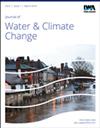Predicting rainfall response to climate change and uncertainty analysis: introducing a novel downscaling CMIP6 models technique based on the stacking ensemble machine learning
IF 2.7
4区 环境科学与生态学
Q2 WATER RESOURCES
引用次数: 2
Abstract
Abstract This study proposes a novel downscaling technique based on stacking ensemble machine learning (SEML) to predict rainfall under climate change. The SEML consists of two levels. Rainfall time series predicted by level 1 algorithms MLR, MNLR, MARS, M5, RF, LSBoost, LSSVM-GS, and a novel hybrid algorithm namely LSSVM-RUN) are used as inputs to the level 2 machine learning algorithm (MARS and LSSVM_RUN). Then, meta-algorithms of SEML predict rainfall based on eight predicted rainfall in level 1. This approach boosts prediction accuracy by utilizing the strong points of different machine learning (ML) algorithms. Results showed that MARS and LSSVM-RUN could be employed to improve the modeling results as meta-algorithms (level 2 of the SEML). Three global climate models (GCMs) in the historical period (1985–2014) and three SSP scenarios in the future period (2021–2050) were considered for downscaling and predicting rainfall at Lake Urmia and Sefidrood basins. Using meta-algorithms, the prediction results showed that rainfall in all scenarios and stations decreased between 0.02 and 0.20% (except Takab station in model CanESM5 scenarios). Hence, the proposed stacking ensemble ML has the potential for modeling and predicting precipitation with good accuracy and high reliability.降雨对气候变化的响应预测及不确定性分析——基于叠加集成机器学习的降尺度CMIP6模型技术
摘要提出了一种基于叠加集成机器学习(SEML)的降尺度预测技术,用于气候变化下的降雨预测。SEML由两个级别组成。使用由一级算法MLR、MNLR、MARS、M5、RF、LSBoost、LSSVM-GS和一种新型混合算法LSSVM-RUN预测的降雨时间序列作为二级机器学习算法(MARS和LSSVM_RUN)的输入。然后,SEML的元算法基于8个1级降雨预测进行降雨预测。这种方法通过利用不同机器学习(ML)算法的优点来提高预测的准确性。结果表明,MARS和LSSVM-RUN作为元算法(SEML的第2级)可以改善建模结果。考虑了历史时期(1985—2014年)的3种全球气候模式(GCMs)和未来时期(2021—2050年)的3种SSP情景,对乌尔米亚湖和塞菲德鲁德流域的降水进行了降尺度和预测。元算法预测结果表明,除CanESM5模式情景下的Takab站外,所有情景和站的降雨量均减少了0.02 ~ 0.20%。因此,所提出的叠加集成机器学习具有建模和预测降水的良好精度和高可靠性的潜力。
本文章由计算机程序翻译,如有差异,请以英文原文为准。
求助全文
约1分钟内获得全文
求助全文
来源期刊

Journal of Water and Climate Change
WATER RESOURCES-
CiteScore
4.80
自引率
10.70%
发文量
168
审稿时长
>12 weeks
期刊介绍:
Journal of Water and Climate Change publishes refereed research and practitioner papers on all aspects of water science, technology, management and innovation in response to climate change, with emphasis on reduction of energy usage.
 求助内容:
求助内容: 应助结果提醒方式:
应助结果提醒方式:


